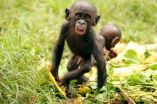(Press-News.org) CHAPEL HILL, N.C. – Some brain changes that are found in adults with common gene variants linked to disorders such as Alzheimer's disease, schizophrenia, and autism can also be seen in the brain scans of newborns.
"These results suggest that prenatal brain development may be a very important influence on psychiatric risk later in life," said Rebecca C. Knickmeyer, PhD, lead author of the study and assistant professor of psychiatry in the University of North Carolina School of Medicine. The study was published by the journal Cerebral Cortex on Jan. 3, 2013.
The study included 272 infants who received MRI scans at UNC Hospitals shortly after birth. The DNA of each was tested for 10 common variations in 7 genes that have been linked to brain structure in adults. These genes have also been implicated in conditions such as schizophrenia, bipolar disorder, autism, Alzheimer's disease, anxiety disorders and depression.
For some polymorphisms – such as a variation in the APOE gene which is associated with Alzheimer's disease – the brain changes in infants looked very similar to brain changes found in adults with the same variants, Knickmeyer said. "This could stimulate an exciting new line of research focused on preventing onset of illness through very early intervention in at-risk individuals."
But this was not true for every polymorphism included in the study, said John H. Gilmore, MD, senior author of the study and Thad & Alice Eure Distinguished Professor and Vice Chair for Research and Scientific Affairs in the UNC Department of Psychiatry.
For example, the study included two variants in the DISC1 gene. For one of these variants, known as rs821616, the infant brains looked very similar to the brains of adults with this variant. But there was no such similarity between infant brains and adult brains for the other variant, rs6675281.
"This suggests that the brain changes associated with this gene variant aren't present at birth but develop later in life, perhaps during puberty," Gilmore said.
"It's fascinating that different variants in the same gene have such unique effects in terms of when they affect brain development," said Knickmeyer.
INFORMATION:
In addition to Knickmeyer and Gilmore, authors of the study were Jiaping Wang, PhD; Hongtu Zhu, PhD; Xiujuan Geng, PhD; Sandra Woolson, MPh; Robert M. Hamer, PhD; Thomas Konneker, BA; Weili Lin, PhD; and Martin Styner, PhD. All are at UNC except Konneker, who was at UNC but is now a PhD student at the University of California, Santa Cruz.
The study was funded by grants from the National Institutes of Health.
Risk genes for Alzheimer's and mental illness linked to brain changes at birth
2013-01-03
ELSE PRESS RELEASES FROM THIS DATE:
Food for friendship: Bonobos share with strangers in exchange for company
2013-01-03
Bonobos voluntarily share food and will even forego their own meals for a stranger, but only if the recipient offers them social interaction, according to research published January 2 by Jingzhi Tan and Brian Hare of Duke University.
In a series of experiments, the researchers found that bonobos would voluntarily forego their food and offer it to a stranger in exchange for social interaction. The authors found that the bonobos' behavior was at least partially driven by unselfish motivations, since the animals helped strangers acquire food that was out of reach even when ...
ALMA sheds light on planet-forming gas streams
2013-01-03
Astronomers using the Atacama Large Millimeter/submillimeter Array (ALMA) telescope have seen a key stage in the birth of giant planets for the first time. Vast streams of gas are flowing across a gap in the disc of material around a young star. These are the first direct observations of such streams, which are expected to be created by giant planets guzzling gas as they grow. The result is published on 2 January 2013 in the journal Nature.
The international team of astronomers studied the young star HD 142527, over 450 light-years from Earth, which is surrounded by a ...
Nature: Political action the biggest swing factor in meeting climate targets
2013-01-03
The new study, published today in the journal Nature, examined the probability of keeping average global temperatures from rising more than 2°C above preindustrial levels under varying levels of climate policy stringency, and thus mitigation costs. In addition, the study for the first time quantified and ranked the uncertainties associated with efforts to mitigate climate change, including questions about the climate itself, uncertainties related to future technologies and energy demand, and political uncertainties as to when action will be taken.
The climate system itself ...
Our galaxy's 'geysers' are towers of power
2013-01-03
VIDEO:
This is Ettore Carretti talking about how the telescope makes maps of the sky.
Click here for more information.
"Monster" outflows of charged particles from the centre of our Galaxy, stretching more than halfway across the sky, have been detected and mapped with CSIRO's 64-m Parkes radio telescope.
Corresponding to the "Fermi Bubbles" found in 2010, the outflows were detected by astronomers from Australia, the USA, Italy and The Netherlands. The finding is reported ...
Study refutes accepted model of memory formation
2013-01-03
A study by Johns Hopkins researchers has shown that a widely accepted model of long-term memory formation — that it hinges on a single enzyme in the brain — is flawed. The new study, published in the Jan. 2 issue of Nature, found that mice lacking the enzyme that purportedly builds memory were in fact still able to form long-term memories as well as normal mice could.
"The prevailing theory is that when you learn something, you strengthen connections between your brain cells called synapses," explains Richard Huganir, Ph.D., a professor and director of the Johns Hopkins ...
ALMA shows how young star and planets grow simultaneously
2013-01-03
Astronomers have used the ALMA telescope to get their first glimpse of a fascinating stage of star formation in which planets forming around a young star are helping the star itself continue to grow, resolving a longstanding mystery. The young system, about 450 light-years from Earth, is revealing its complex gravitational dance to the ever-sharpening vision of the Atacama Large Millimeter/submillimeter Array (ALMA), scheduled for completion this year.
As young stars gather material from their surrounding clouds of gas and dust, the incoming material forms a flat, spinning ...
Galactic geysers fuelled by star stuff
2013-01-03
Enormous outflows of charged particles from the centre of our Galaxy, stretching more than halfway across the sky and moving at supersonic speeds, have been detected and mapped with CSIRO's 64-m Parkes radio telescope.
Corresponding to the "Fermi Bubbles" found in 2010, the recent observations of the phenomenon were made by a team of astronomers from Australia, the USA, Italy and The Netherlands, with the findings reported in today's issue of Nature.
"There is an incredible amount of energy in the outflows," said co-author Professor Lister-Staveley-Smith from The University ...
The laws of global warming
2013-01-03
With policymakers and political leaders increasingly unable to combat global climate change, more scientists are considering the use of manual manipulation of the environment to slow warming's damage to the planet.
But a University of Iowa law professor believes the legal ramifications of this kind of geo-engineering need to be thought through in advance and a global governance structure put in place soon to oversee these efforts.
"Geo-engineering is a global concern that will have climate and weather impacts in all countries, and it is virtually inevitable that some ...
Communication is key to medication adherence
2013-01-03
Even the best medicines in the world can be rendered ineffective if they are not taken as prescribed. The problem known as medication "non-adherence" is a major health issue in the United States, contributing to worse outcomes for people who have diabetes and other chronic diseases.
Now a study led by researchers at the University of California, San Francisco (UCSF), San Francisco General Hospital and Trauma Center (SFGH) and the Kaiser Permanente Division of Research has identified a significant factor that contributes to poor drug adherence – ineffective communication.
Described ...
Bisexual men on the 'down low' run risk for poor mental health
2013-01-03
January 2, 2013 -- Bisexual men are less likely to disclose and more likely to conceal their sexual orientation than gay men. In the first study to look at the mental health of this population, researchers at Columbia University's Mailman School of Public Health found that greater concealment of homosexual behavior was associated with more symptoms of depression and anxiety.
The study published in the American Psychological Association's Journal of Consulting and Clinical Psychology, examined bisexual men "on the down low," a subgroup of bisexual men who live predominantly ...


